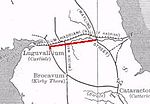Haydon Bridge High School
Haydon Bridge High School is a mixed secondary day school located in Haydon Bridge in the English county of Northumberland. The current headteacher is David Nisbet, who took over in September 2023. It is a foundation school administered by Northumberland County Council, It is claimed to have the largest catchment area of any school in England, reputedly covering an area larger than that encompassed by the M25, the orbital motorway around London. In April 2016, Ofsted judged the school standards as "below par". Haydon Bridge High School offers GCSEs and BTECs as programmes of study for pupils, while students in the sixth form have the option to study from a range of A-levels and further BTECs.
Excerpt from the Wikipedia article Haydon Bridge High School (License: CC BY-SA 3.0, Authors).Haydon Bridge High School
North Bank,
Geographical coordinates (GPS) Address Phone number Website External links Nearby Places Show on map
Geographical coordinates (GPS)
| Latitude | Longitude |
|---|---|
| N 54.97533 ° | E -2.25281 ° |
Address
Haydon Bridge High School
North Bank
NE47 6LR , Haydon
England, United Kingdom
Open on Google Maps






